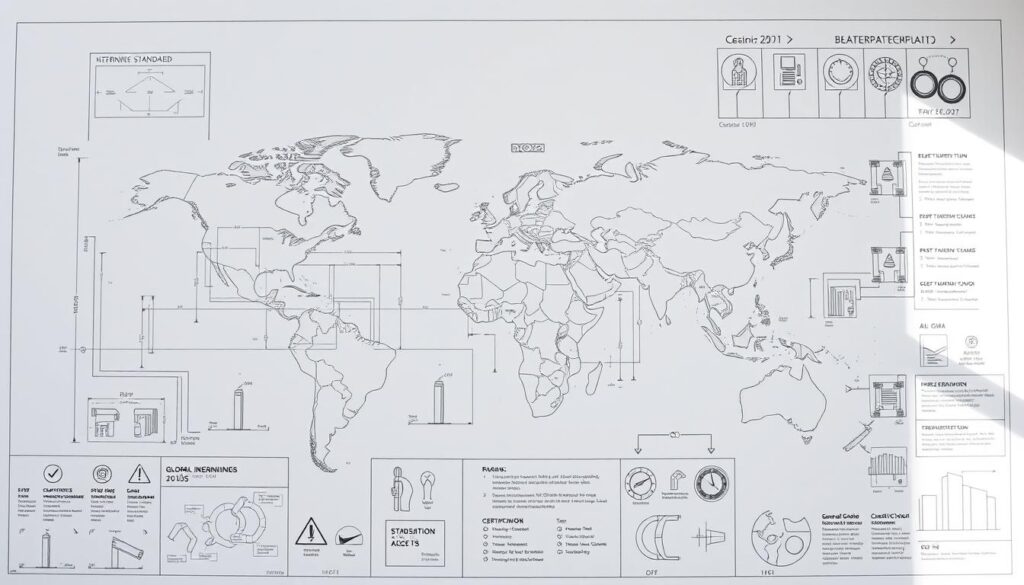Can adherence to international guidelines make or break an engineering project’s success?
Navigating the complex landscape of global engineering regulations is crucial for ensuring project success and maintaining industry credibility. As engineering firms expand their operations globally, they must comply with diverse regulatory requirements and implement robust quality management systems.
The importance of accreditation in engineering education cannot be overstated, as it ensures that future engineers are equipped to handle the challenges of an increasingly globalized industry.
Key Takeaways
- Adherence to international guidelines is crucial for engineering project success.
- Global engineering regulations vary across regions and industries.
- Robust quality management systems are essential for compliance.
- Accreditation in engineering education ensures readiness for global challenges.
- Engineering firms must adapt to diverse regulatory requirements.
Understanding Engineering Standards
Engineering standards are the backbone of modern engineering, providing a common language and framework for professionals worldwide. These standards are crucial in ensuring that products and services meet certain criteria for safety, reliability, and performance.
Definition of Engineering Standards
Engineering standards are industry standards worldwide that define the specifications and guidelines for engineering practices. They encompass a broad range of areas, including design, manufacturing, testing, and certification. For instance, engineering standards provide a common framework that facilitates the development of compatible and interoperable products.
These universal engineering specifications are developed through a consensus-based process involving experts from various fields. They are designed to be adaptable to different contexts and technologies, ensuring their relevance over time.
Importance of Standards in Engineering
The importance of global engineering requirements cannot be overstated. Standards play a vital role in enhancing safety by setting minimum requirements for the design and manufacture of products. They also facilitate international trade by providing a common language and set of expectations among manufacturers, suppliers, and customers.
Moreover, standards contribute to the quality and reliability of products. By following established guidelines, engineers can ensure that their designs and products meet the necessary criteria for performance and safety. This, in turn, boosts consumer confidence and reduces the risk of product failures.
In conclusion, understanding and adhering to engineering standards is essential for any engineering professional. It not only ensures compliance with regulatory requirements but also enhances the quality and safety of products and services.
History of Engineering Standards
The history of engineering standards is a story of gradual development and international cooperation. As technology advanced and global trade increased, the need for unified standards became evident.

Engineering standards have evolved significantly over the decades, influenced by technological advancements, industrial growth, and the need for international cooperation. In the early days, standards were often local or national, varying significantly from one country to another. However, as global trade and technological collaboration increased, the necessity for worldwide standards for engineering became apparent.
Evolution Over Decades
The evolution of global engineering norms has been a gradual process. Initially, standards were developed to address specific local needs. As industries expanded and international trade flourished, the need for consistent and compatible standards across borders became a priority. This led to the establishment of international organizations dedicated to developing and maintaining global standards.
For instance, the development of standards for materials and manufacturing processes has been crucial. The NASA’s standards for engineering provide a notable example of how stringent standards can ensure safety and efficiency in complex engineering projects.
Key Milestones in Standardization
Several key milestones mark the history of standardization in engineering. The establishment of organizations like the International Organization for Standardization (ISO) in 1947 was a significant step towards global standardization. ISO’s mission to develop and publish international standards for various industries has been instrumental in promoting worldwide standards for engineering.
- Development of the first international standards for quality management (ISO 9001)
- Establishment of standards for environmental management (ISO 14001)
- Creation of industry-specific standards for sectors like aerospace and automotive
These milestones highlight the ongoing efforts to harmonize engineering practices globally, facilitating international trade and cooperation.
Types of Engineering Standards
Engineering standards can be broadly classified into international, national, and industry-specific categories. This classification helps in understanding the scope and application of each standard in various engineering contexts.
International Standards
International standards are developed and agreed upon by international bodies such as the International Organization for Standardization (ISO). These standards facilitate global trade and cooperation by providing a common framework that can be adopted across different countries. For instance, ISO 9001 is a widely recognized standard for quality management systems.
“The adoption of international standards helps in reducing technical barriers to trade and promotes the global exchange of goods and services,” as emphasized by the World Trade Organization.
National Standards
National standards are specific to a country and are developed by national standards bodies. For example, in the United States, the American National Standards Institute (ANSI) oversees the development of national standards. These standards are tailored to meet the specific needs and regulations of the country.
National standards may sometimes be more stringent than international standards, reflecting local conditions and requirements. Compliance with national standards is often mandatory for businesses operating within a country’s borders.
Industry-Specific Standards
Industry-specific standards are designed for particular sectors, such as aerospace, automotive, or healthcare. These standards address the unique challenges and requirements of each industry, ensuring safety, efficiency, and interoperability.
For example, in the aerospace industry, standards like AS9100 are critical for quality management, while in the healthcare sector, standards such as ISO 13485 focus on medical devices. Industry-specific standards are often developed in collaboration with industry experts and regulatory bodies.
The use of industry-specific standards helps companies to demonstrate their commitment to quality and safety, enhancing their reputation and competitiveness in the market.
Major Organizations in Standardization
Several key organizations are at the forefront of creating and maintaining the global engineering standards that govern various industries. These organizations play a vital role in ensuring that products and services are safe, reliable, and compatible across different markets.
International Organization for Standardization (ISO)
The International Organization for Standardization (ISO) is one of the most recognized standardization bodies globally. ISO develops and publishes international standards for various industries, facilitating global trade and cooperation. With its broad scope, ISO covers standards ranging from quality management (ISO 9001) to environmental management (ISO 14001).
American National Standards Institute (ANSI)
The American National Standards Institute (ANSI) is a key player in standardization in the United States. ANSI oversees the development of standards and conformity assessment systems, ensuring that products and services meet certain criteria. ANSI is also involved in international standardization efforts, often working closely with ISO and other global bodies. For more information on ANSI’s standards, you can visit their standards database.
International Electrotechnical Commission (IEC)
The International Electrotechnical Commission (IEC) is another pivotal organization in the standardization landscape, focusing on electrical and electronic technologies. The IEC develops standards that ensure the safety, efficiency, and interoperability of electrical devices and systems. Its standards are crucial for industries dealing with electrical engineering and electronics.

These organizations work together to create a cohesive global standards framework, facilitating international trade and technological advancement. Their efforts ensure that products and services are not only compliant with local regulations but also competitive in the global market.
The Role of Standards in Globalization
In today’s globalized economy, engineering standards are crucial for facilitating international collaboration and trade. The adoption of universal engineering specifications enables companies to operate seamlessly across borders, fostering a more interconnected world.
The significance of global engineering requirements lies in their ability to streamline processes, reduce barriers to entry, and enhance the overall quality of products and services. By adhering to these standards, businesses can ensure compliance with international regulations, thereby avoiding costly redesigns or legal issues.
Facilitating International Trade
Standards play a vital role in facilitating international trade by providing a common language and framework for businesses to operate within. This harmonization allows for easier exchange of goods and services across borders, promoting economic growth and cooperation among nations.
For instance, companies looking to expand their operations globally can benefit from understanding global engineering requirements, ensuring they meet the necessary standards for international collaboration.
Enhancing Safety and Quality
Beyond facilitating trade, global engineering standards also enhance safety and quality by establishing rigorous guidelines that products and services must meet. This not only protects consumers but also helps in building trust among international partners, further facilitating global trade.
The emphasis on universal engineering specifications ensures that products are designed and manufactured with safety and quality in mind, reducing the risk of failures and accidents. This, in turn, contributes to a more reliable and efficient global supply chain.
How Standards Affect Engineering Design
The impact of global engineering standards on design cannot be overstated. As engineers, understanding and implementing these standards is crucial for creating designs that are not only compliant with international regulations but also competitive in the global market.

Incorporating Standards into Workflow
Incorporating engineering standards global into the design workflow is essential for ensuring that products are safe, efficient, and meet customer expectations. This involves several key steps:
- Identifying relevant standards for the project
- Integrating these standards into the design process from the outset
- Regularly reviewing and updating designs to ensure ongoing compliance
By following these steps, engineers can ensure that their designs are aligned with global engineering norms, reducing the risk of costly redesigns or compliance issues down the line. For more insights on integrating international standards into engineering design, visit this LinkedIn article.
Case Studies of Successful Implementation
Several case studies highlight the successful implementation of global engineering standards in design. For instance:
- A leading automotive manufacturer adopted international safety standards to enhance vehicle safety, resulting in a significant reduction in accidents.
- A technology firm integrated global interoperability standards into their product design, enabling seamless integration with other systems worldwide.
These examples demonstrate the tangible benefits of adhering to global engineering standards, from improved safety to enhanced marketability.
Challenges in Adopting Global Standards
As the world becomes more interconnected, the challenges in adopting global engineering standards come to the forefront. The adoption of worldwide standards for engineering is crucial for ensuring safety, quality, and efficiency across different projects and regions.
Cultural and Regional Differences
One of the significant challenges in implementing global standards is navigating cultural and regional differences. Different regions have unique practices, preferences, and regulatory requirements that can affect how engineering codes global are adopted and implemented.
For instance, what is considered standard practice in one country might not be acceptable in another due to varying cultural norms or historical practices. This discrepancy can lead to confusion and complications in international projects.
Compliance and Enforcement Issues
Another challenge is ensuring compliance with and enforcement of global standards. Even when standards are adopted, their enforcement can be inconsistent due to differences in legal frameworks, inspection practices, and penalties for non-compliance.
Effective implementation of engineering codes global requires robust mechanisms for monitoring compliance and addressing violations. This can be particularly challenging in regions with less stringent regulatory oversight or limited resources for enforcement.
To overcome these challenges, it’s essential to foster international cooperation and understanding among stakeholders. This includes engaging with local communities, governments, and professional bodies to promote the benefits of global standards and to address concerns related to their adoption.
For more insights on how global standards are applied in project management, visit this resource on civil engineering in project management.
The Future of Engineering Standards
As the world becomes increasingly interconnected, the future of engineering standards is poised to undergo significant transformations. The rapid evolution of technology and the growing need for sustainable practices are driving changes in how standards are developed and implemented globally.

Trends in Standardization
Several key trends are shaping the future of standardization in engineering. These include:
- Increased focus on sustainability and environmental impact
- Integration of emerging technologies like AI and IoT into standardization processes
- Greater emphasis on global harmonization of standards
- Enhanced collaboration among stakeholders, including industry, government, and academia
For instance, the adoption of sustainable building materials is becoming more prevalent, reflecting a broader trend towards environmentally conscious engineering practices. This shift is expected to continue, with standards evolving to accommodate new materials and technologies.
Impact of Technology on Standards
Technology is playing a pivotal role in shaping the future of engineering standards. Advances in areas such as artificial intelligence, blockchain, and the Internet of Things (IoT) are not only influencing the development of new standards but also enhancing compliance and enforcement.
Some of the ways technology is impacting standards include:
- Improved data collection and analysis for more informed standard development
- Enhanced traceability and transparency through blockchain technology
- Increased efficiency in compliance monitoring through IoT devices
As technology continues to evolve, it is likely that engineering standards will become more dynamic, responsive to change, and effective in ensuring safety, quality, and sustainability.
Importance of Collaboration in Standards Development
Effective collaboration is crucial for creating universal engineering specifications that are adopted worldwide. The development of global engineering standards is a complex process that requires the active participation of various stakeholders, including industry experts, regulatory bodies, and end-users.
Stakeholder Engagement
Stakeholder engagement is a critical component of standards development. It ensures that the standards are relevant, practical, and meet the needs of all parties involved. For instance, the collaboration among engineers and standards organizations has led to the development of standards that facilitate better collaboration and compliance.
- Industry experts provide technical insights and practical experience.
- Regulatory bodies ensure that standards comply with legal requirements.
- End-users offer feedback on the usability and effectiveness of the standards.
Building Consensus Across Borders
Building consensus across borders is essential for the adoption of global engineering requirements. This involves reconciling different national and industry-specific standards into a cohesive framework that can be universally applied. The process requires:
- Understanding the diverse needs and practices of different regions and industries.
- Negotiating and compromising to reach a mutually acceptable standard.
- Ensuring that the final standard is robust, reliable, and meets the global engineering requirements.
By fostering collaboration and consensus, the engineering community can develop standards that not only enhance safety and quality but also facilitate international trade and cooperation. As the world becomes increasingly interconnected, the importance of collaboration in standards development will continue to grow.
Navigating Compliance with Global Standards
Navigating the complex landscape of global engineering standards is crucial for professionals in the field. As engineering projects become increasingly global, understanding and complying with these standards is more important than ever.
Steps for Engineering Professionals
To navigate compliance with global standards effectively, engineering professionals should follow several key steps:
- Stay informed about the latest developments in global engineering standards.
- Understand the specific standards relevant to their projects and industry.
- Incorporate these standards into their workflow and design processes.
- Engage with relevant stakeholders and organizations to ensure compliance.
For more detailed guidance on navigating compliance and quality standards in engineering projects, visit Navigating Compliance and Quality Standards.

Resources for Staying Informed
Several resources are available to help engineering professionals stay informed about global engineering standards:
| Resource | Description | Frequency of Update |
|---|---|---|
| International Organization for Standardization (ISO) | Provides information on international standards for various industries. | Quarterly |
| American National Standards Institute (ANSI) | Offers standards and conformity assessment programs. | Monthly |
| International Electrotechnical Commission (IEC) | Publishes standards for electrical and electronic technologies. | Bi-annually |
By following these steps and utilizing the available resources, engineering professionals can ensure compliance with global engineering standards and contribute to the success of their projects.
Training and Education on Global Standards
The rapidly evolving field of engineering demands a strong foundation in global standards to ensure quality and safety. As engineers work on projects that span multiple countries, understanding worldwide standards for engineering is crucial for success.
Continuous learning is vital in the field of engineering, where standards and technologies are constantly evolving. Engineers must stay updated on the latest engineering codes global to remain competitive and compliant with international regulations.
Importance of Continuous Learning
Continuous learning enables engineers to adapt to new standards and technologies, ensuring their work meets the highest quality and safety standards. It also fosters innovation and collaboration across borders. For instance, understanding the standards set by organizations like the International Organization for Standardization (ISO) can significantly enhance an engineer’s ability to work on global projects.
Moreover, continuous education helps engineers navigate the complexities of global standards, reducing the risk of non-compliance and associated penalties. It also opens up new opportunities for career advancement and professional growth.
Available Certification Programs
Several certification programs are available for engineers looking to enhance their knowledge of global standards. These programs cover a range of topics, from engineering codes global to industry-specific standards. For example, the top civil engineering programs for international often include coursework on global standards and their application.
Some notable certification programs include those offered by the American National Standards Institute (ANSI) and the International Electrotechnical Commission (IEC). These programs provide engineers with the credentials needed to demonstrate their expertise in global standards.
By investing in continuous learning and certification, engineers can stay ahead in their careers and contribute to the development of safe, efficient, and innovative engineering solutions worldwide.
Case Studies of Global Standards in Action
Global standards have been instrumental in facilitating complex engineering projects across borders. By adhering to industry standards worldwide, companies can ensure that their projects meet the necessary requirements for safety, quality, and efficiency.
Examples of Successful Global Engineering Projects
Several high-profile engineering projects have successfully implemented global engineering regulations, showcasing the benefits of standardization. For instance, the construction of the Channel Tunnel between the UK and France required strict adherence to international safety standards.
The project involved collaboration between multiple stakeholders from different countries, necessitating the use of common standards to ensure compatibility and safety. The successful completion of the tunnel demonstrated the effectiveness of global standards in facilitating large-scale international projects.

Another example is the development of the Airbus A380, which involved manufacturers from several countries. The use of industry standards worldwide enabled the integration of components from different suppliers, ensuring that the final product met the required safety and performance standards.
Lessons Learned from Global Compliance
While the adoption of global standards has numerous benefits, there are also challenges to be addressed. One of the key lessons learned from global compliance is the importance of cultural and regional differences in the implementation of standards.
| Project | Standards Implemented | Outcome |
|---|---|---|
| Channel Tunnel | International Safety Standards | Successful completion |
| Airbus A380 | Industry Standards Worldwide | Met safety and performance standards |
By understanding these differences and adapting standards accordingly, companies can improve their compliance with global engineering regulations. This not only enhances the quality and safety of their projects but also facilitates their entry into new markets.
Key Takeaways:
- Global standards facilitate complex engineering projects.
- Adherence to industry standards worldwide ensures safety and quality.
- Cultural and regional differences impact the implementation of standards.
Conclusion: The Path Forward in Engineering Standards
Navigating global engineering standards is crucial for the success of engineering projects worldwide. As discussed, understanding and implementing international engineering guidelines can significantly enhance the quality, safety, and efficiency of these projects.
Key Takeaways
The importance of adhering to engineering standards global cannot be overstated. These standards facilitate international trade, ensure safety, and promote quality. Major organizations such as the International Organization for Standardization (ISO) and the American National Standards Institute (ANSI) play pivotal roles in developing and maintaining these standards.
Action for a Globalized Engineering Community
Engineers and organizations must stay informed about the latest developments in international engineering guidelines. By doing so, they can ensure compliance, foster collaboration, and drive innovation. Embracing global engineering standards is a step towards a more interconnected and efficient engineering community.
